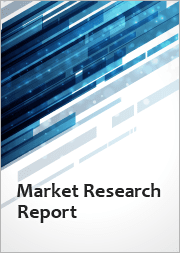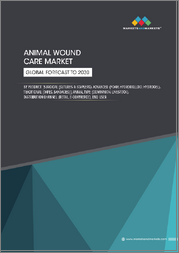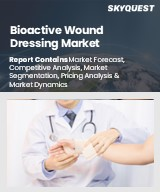
|
시장보고서
상품코드
1479125
상처용 생물제제 시장 - 세계 및 지역별 분석 : 제품별, 지역별, 국가별 분석, 경쟁 환경: 분석 및 예측(2023-2030년)Wound Biologics Market - A Global and Regional Analysis: Focus on Product, Region, Country-Level Analysis, and Competitive Landscape Analysis and Forecast, 2023-2030 |
||||||
세계 상처용 생물제제 시장 규모는 2022년 18억 5,140만 달러에 달할 것으로 예상됩니다.
이 시장은 2023년부터 2030년까지 7.71%의 연평균 복합 성장률(CAGR)로 성장하여 2030년 말에는 33억 2,150만 달러 규모로 성장할 것으로 예상됩니다. 상처용 생물제제 시장은 상처 및 화상 치료에 대한 수요 증가로 인해 이러한 성장세를 보이고 있습니다. 이러한 성장의 원동력으로는 화상 발생률 증가, 당뇨병성 족부 궤양 및 욕창의 유병률 증가, 상처 치료 강화를 위한 정부 주도 이니셔티브 등이 있습니다.
| 주요 시장 통계 | |
|---|---|
| 예측 기간 | 2023년-2030년 |
| 2023년 평가 | 19억 7,4700만 달러 |
| 2030년 전망 | 33억 2,150만 달러|
| CAGR | 7.71% |
상처용 생물제제는 인체 세포, 조직, 천연물 등 생물학적 자원에서 추출한 첨단 의료 재료입니다. 이 제품들은 당뇨병성 궤양, 욕창, 정맥성 궤양과 같은 만성 상처와 부상이나 수술로 인한 급성 상처 등 다양한 유형의 상처를 가진 환자의 상처 치유와 조직 재생을 촉진하기 위해 특별히 고안된 제품입니다. 상처용 생물제제에는 성장인자, 세포외 매트릭스, 세포치료제, 생체공학적으로 제조된 대체 피부 등이 포함되며, 모두 신체의 자연 치유 과정을 촉진하여 상처 봉합과 조직 회복을 개선하는 것을 목표로 합니다. 최근 시장 개발로는 2023년 3월 바이오티슈가 플로리다 주 드럴에 위치한 시설의 확장 및 개보수를 완료한 것을 들 수 있습니다.
이 보고서는 세계 상처용 생물제제 시장에 대해 조사했으며, 시장 개요와 함께 제품별/지역별 동향, 시장 진출기업 프로파일 등의 정보를 제공합니다.
목차
주요 요약
제1장 시장
- 제품 정의
- 포함 기준과 제외 기준
- 주요 질문에 대한 답변
- 분석과 예측 노트
- 주요 조사 결과
제2장 제품
- 제품 세분화
- 제품 개요
- 세계의 상처용 생물제제 시장(제품 유형별)
제3장 지역
- 지역별 개요
- 북미
- 라틴아메리카
- 유럽
- 아시아태평양
- 기타 지역
제4장 시장 - 경쟁 벤치마킹
- 주요 전략과 개발
- 주요 기업 에코시스템
제5장 조사 방법
LSH 24.05.22Global Wound Biologics Market Industry Overview
The global wound biologics market was valued at $1,851.4 million in 2022 and is anticipated to grow to $3,321.5 million by the end of 2030. This market is expected to expand at a compound annual growth rate (CAGR) of 7.71% between 2023 and 2030. Such growth is being experienced by the wound biologics market, owing to increasing demand for treating wounds and burn injuries. Drivers of this growth include the rising incidence of burn injuries, the expanding prevalence of diabetic foot ulcers and pressure ulcers, and government-led initiatives aimed at enhancing wound care treatments.
Market Introduction
| KEY MARKET STATISTICS | |
|---|---|
| Forecast Period | 2023 - 2030 |
| 2023 Evaluation | $1,974.7 Million |
| 2030 Forecast | $3,321.5 Million |
| CAGR | 7.71% |
Wound biologics products are advanced medical materials derived from biological sources such as human cells, tissues, or natural substances. These products are specifically designed to facilitate wound healing and tissue regeneration in patients with various types of wounds, including chronic wounds such as diabetic ulcers, pressure ulcers, and venous ulcers, as well as acute wounds from injuries or surgeries. Wound biologics can include growth factors, extracellular matrices, cellular therapies, and bioengineered skin substitutes, all aimed at promoting the natural healing processes of the body to achieve better wound closure and tissue repair. One recent development that has taken place in the market was in March 2023 when BioTissue completed a facility expansion and renovation in Doral, Florida, to support the growing demand and future expansion of its biologics product portfolio.
Market Segmentation:
Segmentation 1: by Product
- Growth Factors
- Skin Substitutes
- Topical Agents
Skin Substitutes to Lead the Global Wound Biologics Market (by Product)
Based on product, the wound biologics market is led by skin substitutes, which held a 63.78% share in 2022.
Segmentation 2: by Region
- North America
- U.S.
- Canada
- Europe
- U.K.
- Germany
- France
- Italy
- Spain
- Netherlands
- Switzerland
- Russian Federation
- Turkey
- Poland
- Belgium
- Sweden
- Ireland
- Norway
- Austria
- Denmark
- Finland
- Portugal
- Czech Republic
- Romania
- Greece
- Slovakia
- Ukraine
- Asia-Pacific
- Japan
- China
- India
- South Korea
- Australia
- Malaysia
- Thailand
- Latin America
- Brazil
- Mexico
- Colombia
- Argentina
- Chile
- Rest-of-the-World
Regionally, North America maintains a dominant position, and it is expected to grow through a steady compound annual growth rate (CAGR) of 6.66% from 2023 to 2030. This sustained growth can be attributed to the region's advanced healthcare infrastructure, widespread awareness of wound management, and a notable increase in chronic wounds among its aging populace.
The emphasis on R&D in North America has also facilitated the emergence of innovative wound biologics products, supported by a strong regulatory environment and healthcare policies favouring advanced wound care solutions. The emphasis on R&D in North America has also facilitated the emergence of innovative wound biologics, supported by a strong regulatory environment and healthcare policies favouring advanced wound care solutions.
Asia-Pacific and the Rest-of-the-World regions are projected to experience the highest growth rates, with CAGRs of 11.49% and 11.29%, respectively, indicating a rapidly expanding market presence. The growth in these regions is likely driven by improving healthcare infrastructure, rising awareness of effective wound care, and increasing accessibility to advanced medical treatments. Overall, the wound biologics market globally has been characterized by regional growth patterns influenced by healthcare advancements, demographic shifts, and a collective focus on improving wound care outcomes.
Recent Developments in the Wound Biologics Market
- In May 2023, Cellularity disclosed a significant purchase order amounting to $45 million in accordance with the first private label agreement in the Middle East for Cellularity Inc.'s halal-certified biomaterial products. The products, namely Biovance, Biovance 3L, Interfyl, and CentaFlex have obtained halal certification.
- In January 2022, Gunze Limited announced the commencement of Epiflex sales by Gunze Medical Limited, marking the first and only approved product available in Japan. It is important to note that Epiflex is a registered trademark of MiMedx Group, Inc.
How can this Report add value to an Organization?
Product/Innovation Strategy: The report can highlight current market gaps and emerging patient needs, guiding companies in developing new products or enhancing existing offerings.
Growth/Marketing Strategy: Regional analysis offers insights into market size, growth rates, and competitive landscapes across different territories, assisting in strategic planning for geographic expansion or consolidation.
Competitive Strategy: Understanding future market trends and growth forecasts allows companies to anticipate changes in the competitive landscape, adjust their strategies accordingly, and identify early opportunities for innovation and expansion.
Methodology
Key Considerations and Assumptions in Market Engineering and Validation
- The base year considered for the calculation of the market size is 2022. A historical year analysis has been done for the period FY2019-FY2021. The market size has been estimated for FY2022 and projected for the period FY2023-FY2030
- The scope of this report has been carefully derived based on interactions with experts in different companies across the world. This report provides a market study of upstream and downstream products of wound biologics.
- The market contribution of wound biologics products anticipated to be launched in the future has been calculated based on the historical analysis of the solutions.
- Revenues of the companies have been referenced from their annual reports for FY2022 and FY2023. For private companies, revenues have been estimated based on factors such as inputs obtained from primary research, funding history, market collaborations, and operational history.
- The market has been mapped based on the available wound biologics solutions. All the key companies with significant offerings in this field have been considered and profiled in this report.
Primary Research:
The primary sources involve industry experts in wound biologics, including the market players offering products and services. Resources such as CEOs, vice presidents, marketing directors, and salespersons have been interviewed to obtain and verify both qualitative and quantitative aspects of this research study.
The key data points taken from the primary sources include:
- Validation and triangulation of all the numbers and graphs
- Validation of the report's segmentation and key qualitative findings
- Understanding the competitive landscape and business model
- Current and proposed production values of a product by market players
- Percentage split of individual markets for regional analysis
Secondary Research:
Open Sources
- Certified publications, articles from recognized authors, white papers, directories, and major databases, among others
- Annual reports, SEC filings, and investor presentations of the leading market players
- Company websites and detailed study of their product portfolio
- Gold standard magazines, journals, white papers, press releases, and news articles
- Paid databases
The key data points taken from the secondary sources include:
- Segmentations and percentage shares
- Data for market value
- Key industry trends of the top players of the market
- Qualitative insights into various aspects of the market, key trends, and emerging areas of innovation
- Quantitative data for mathematical and statistical calculations
Key Market Players and Competition Synopsis
The global competitive landscape of the wound biologics market is defined by the presence of several key players, each contributing to the market's growth through innovation, business expansion, funding, strategic partnerships, and a focus on expanding product portfolios. Leading companies in this space are distinguished by their commitment to research and development, which enables them to introduce advanced wound care solutions that address a range of needs, from basic wound protection to complex wound management scenarios.
Some prominent names established in this market are:
- AlloSource
- LifeNet Health
- Smith & Nephew plc.
- Sanara MedTech Inc.
- Mtf Biologics
- Becton, Dickinson and Company
- MiMedx Group, Inc.
- TissueTech, Inc.
Table of Contents
Executive Summary
1 Markets
- 1.1 Product Definition
- 1.2 Inclusion and Exclusion Criteria
- 1.2.1 Inclusion
- 1.2.2 Exclusion Criteria
- 1.3 Key Questions Answered
- 1.4 Analysis and Forecast Note
- 1.5 Key Findings
2 Products
- 2.1 Product Segmentation
- 2.2 Product Summary
- 2.3 Global Wound Biologics Market (by Product Type)
- 2.3.1 Growth Factors
- 2.3.2 Skin Substitutes
- 2.3.3 Topical Agents
3 Regions
- 3.1 Regional Summary
- 3.2 North America
- 3.2.1 U.S.
- 3.2.2 Canada
- 3.3 Latin America
- 3.3.1 Argentina
- 3.3.2 Brazil
- 3.3.3 Chile
- 3.3.4 Colombia
- 3.3.5 Mexico
- 3.4 Europe
- 3.4.1 France
- 3.4.2 U.K.
- 3.4.3 Spain
- 3.4.4 Italy
- 3.4.5 Portugal
- 3.4.6 Netherlands
- 3.4.7 Ireland
- 3.4.8 Belgium
- 3.4.9 Switzerland
- 3.4.10 Norway
- 3.4.11 Denmark
- 3.4.12 Sweden
- 3.4.13 Finland
- 3.4.14 Germany
- 3.4.15 Czech Republic
- 3.4.16 Russia Federation
- 3.4.17 Poland
- 3.4.18 Austria
- 3.4.19 Romania
- 3.4.20 Slovakia
- 3.4.21 Greece
- 3.4.22 Turkey
- 3.4.23 Ukraine
- 3.5 Asia-Pacific
- 3.5.1 Australia
- 3.5.2 Japan
- 3.5.3 Malaysia
- 3.5.4 China
- 3.5.5 India
- 3.5.6 Thailand
- 3.5.7 South Korea
- 3.6 Rest-of-the-World
4 Markets - Competitive Benchmarking
- 4.1 Key Strategies and Developments
- 4.2 Key Companies Ecosystem
5 Research Methodology
- 5.1 Data Sources
- 5.1.1 Primary Data Sources
- 5.1.2 Secondary Data Sources
- 5.1.3 Data Triangulation
- 5.2 Market Estimation and Forecast



















